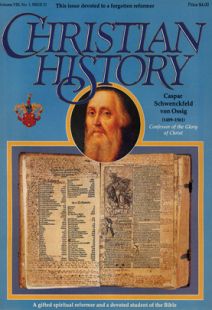The Schwenckfeld Bible
THE REFORMATION was a time of reawakening of Bible study, and Caspar Schwenckfeld was a serious student of the Bible. His personal Bible, pictured here and on our cover was printed in Worms, Germany, in 1529, by Anton Koberger. (Koberger had printed a German translation of the Scriptures in Nurnberg in 1483—the year of Luther’s birth, and 51 years before Luther’s own translation of 1534.)
Schwenckfeld’s detailed notes throughout the text show how exhaustive and penetrating was his reading and reflection on the biblical books. Above is the book of Genesis; the woodcut shows the creation, Fall, and expulsion of Adam and Eve. Below is a portion of the book of Psalms, Schwenckfeld especially loved this part of the Bible and viewed it as prophetic of the coming of Christ.
The notes are those of Schwenckfeld and of his scholarly follower Adam Reissner, who possesed Schwenckfeld’s Bible after his death. This Bible is preserved, along with many other reformation-era documents and later Schwenckfelder writings, in the Schwenckfelder Library in Pennsylvania.
By the Editors
[Christian History originally published this article in Christian History Issue #21 in 1989]
Next articles
The Reformation Era
The Reformation of the early sixteenth century was not a single unified movement.
the EditorsThe World of Schwenckfeld’s Birth
Take a trip in a time machine back to Schwenckfeld’s time.
the EditorsThe Germanic States Before the Seventeenth Century
A list of eight German states of the sixteenth century.
the EditorsJourney to Wittenberg
In late November 1525, Schwenckfeld traveled almost 100 miles on horseback from Liegnitz to Wittenberg the fountainhead of the reform movement, and met with Martin Luther and some of his Wittenberg colleagues.
the EditorsSupport us
Christian History Institute (CHI) is a non-profit Pennsylvania corporation founded in 1982. Your donations support the continuation of this ministry
Donate



